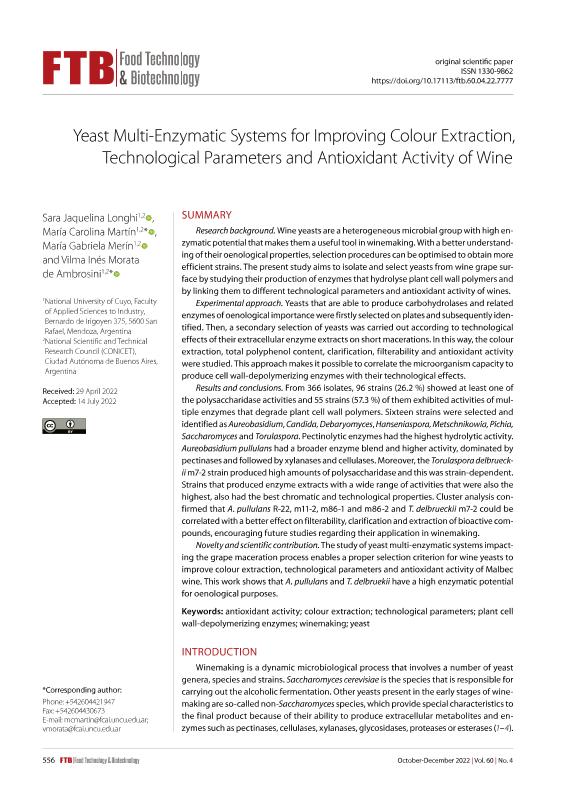Artículo
Yeast Multi-Enzymatic Systems for Improving Colour Extraction, Technological Parameters and Antioxidant Activity of Wine
Fecha de publicación:
10/2022
Editorial:
University of Zagreb. Faculty of Food Technology and Biotechnology
Revista:
Food Technology and Biotechnology
ISSN:
1330-9862
e-ISSN:
1334-2606
Idioma:
Inglés
Tipo de recurso:
Artículo publicado
Clasificación temática:
Resumen
Research background. Wine yeasts are a heterogeneous microbial group with high en-zymatic potential that makes them a useful tool in winemaking. With a better understand-ing of their oenological properties, selection procedures can be optimised to obtain more efficient strains. The present study aims to isolate and select yeasts from wine grape surface by studying their production of enzymes that hydrolyse plant cell wall polymers and by linking them to different technological parameters and antioxidant activity of wines. Experimental approach. Yeasts that are able to produce carbohydrolases and related enzymes of oenological importance were firstly selected on plates and subsequently iden-tified. Then, a secondary selection of yeasts was carried out according to technological effects of their extracellular enzyme extracts on short macerations. In this way, the colour extraction, total polyphenol content, clarification, filterability and antioxidant activity were studied. This approach makes it possible to correlate the microorganism capacity to produce cell wall-depolymerizing enzymes with their technological effects. Results and conclusions. From 366 isolates, 96 strains (26.2 %) showed at least one of the polysaccharidase activities and 55 strains (57.3 %) of them exhibited activities of mul-tiple enzymes that degrade plant cell wall polymers. Sixteen strains were selected and identified as Aureobasidium, Candida, Debaryomyces, Hanseniaspora, Metschnikowia, Pichia, Saccharomyces and Torulaspora. Pectinolytic enzymes had the highest hydrolytic activity. Aureobasidium pullulans had a broader enzyme blend and higher activity, dominated by pectinases and followed by xylanases and cellulases. Moreover, the Torulaspora delbrueck-ii m7-2 strain produced high amounts of polysaccharidase and this was strain-dependent. Strains that produced enzyme extracts with a wide range of activities that were also the highest, also had the best chromatic and technological properties. Cluster analysis con-firmed that A. pullulans R-22, m11-2, m86-1 and m86-2 and T. delbrueckii m7-2 could be correlated with a better effect on filterability, clarification and extraction of bioactive com-pounds, encouraging future studies regarding their application in winemaking. Novelty and scientific contribution. The study of yeast multi-enzymatic systems impact-ing the grape maceration process enables a proper selection criterion for wine yeasts to improve colour extraction, technological parameters and antioxidant activity of Malbec wine. This work shows that A. pullulans and T. delbruekii have a high enzymatic potential for oenological purposes.
Archivos asociados
Licencia
Identificadores
Colecciones
Articulos(CCT - MENDOZA)
Articulos de CTRO.CIENTIFICO TECNOL.CONICET - MENDOZA
Articulos de CTRO.CIENTIFICO TECNOL.CONICET - MENDOZA
Citación
Longhi, Sara Jaquelina; Martín, María Carolina; Merín, María Gabriela; Morata, Vilma Ines; Yeast Multi-Enzymatic Systems for Improving Colour Extraction, Technological Parameters and Antioxidant Activity of Wine; University of Zagreb. Faculty of Food Technology and Biotechnology; Food Technology and Biotechnology; 60; 4; 10-2022; 556-570
Compartir
Altmétricas




